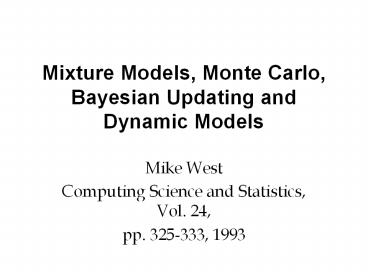Mixture Models, Monte Carlo, Bayesian Updating and Dynamic Models - PowerPoint PPT Presentation
Title:
Mixture Models, Monte Carlo, Bayesian Updating and Dynamic Models
Description:
Mixture Models, Monte Carlo, Bayesian Updating and Dynamic Models. Mike West ... The development of discrete mixture distributions as approximations to priors ... – PowerPoint PPT presentation
Number of Views:176
Avg rating:3.0/5.0
Title: Mixture Models, Monte Carlo, Bayesian Updating and Dynamic Models
1
Mixture Models, Monte Carlo, Bayesian Updating
and Dynamic Models
- Mike West
- Computing Science and Statistics, Vol. 24,
- pp. 325-333, 1993
2
Abstract
- The development of discrete mixture distributions
as approximations to priors and posteriors in
Bayesian analysis - Adaptive density estimation
3
Adaptive mixture modeling
- p(?) the continuous posterior density function
for a continuous parameter vector ?. - g(?) approximating density for importance
sampling function. - T-distribution
- ? ?j, j1,,n random sample from g(?).
- ? wj, j1,,n weights
- wj p(?)/(kg(?))
- k
4
Importance sampling and mixture
- Univariate random sampling
- Direct Bayesian interpretations (based on
mixtures of Dirichlet processes) - Multivariate kernel estimation
- Weighted kernel estimator
5
Adaptive methods of posterior approximation
- Possible patterns of local dependence exhibited
by p(?) - Easy
- Different regions of parameter space are
associated with rather different patterns of
dependence. - V is varying with local j and more heavily
depending on ?j.
6
Adaptive importance sampling
- The importance sampling distribution is sequently
revised based on information derived from
successive Monte Carlo samples.
7
AIS algorithm
- Choose an initial importance sampling
distribution with density g0(?), draw a small
sample n0 and compute weights, deducing the
summary ?0 g0, n0, ?0, ?0. Compute the Monte
Carlo estimates and V0 of the mean and
variance of p0 - Construct a revised importance function g1(?)
using (1) with sample size n0, points ?0,j,
weights w0,j, and variance matrix V0 - Draw a larger sample of size n1 from g1(?), and
replace ?0 with ?1 - Either stop, and base inferences on ?1, or
proceed, if desired, to a further revised version
g2(?), constructed similarly.
8
Approximating mixtures by mixtures
- The computational burden increases if further
refinement with larger sample sizes. - Solution) Using a mixtures of several thousand T
- Reducing the number of components by replacing
nearest neighboring components with some form
of average
9
Clustering routine
- Set r n, starting with the r n component
mixture, choose k lt n as the number of components
for the final, reduced mixture. - Sort r values of ?j. in ? in order of increasing
values of weights wj in ? - Find the index i such that ?j. is the nearest
neighbor of ?1, and reduce the sets ? and ? to
sets of size r 1 by removing components 1 and i,
and inserting average values
10
- Proceed to (2), stopping here only when r k
- The resulting mixture, the locations based on the
final k averaged values, with associated combined
weights, the same scale matrix V but new, and
larger, window-width h based on the current,
reduced sample size r rather than n
11
Sequential updating and dynamic models
- Updating a prior to posterior distribution for a
random quantity or parameter vector based on
received data summarized through a likelihood
function for the parameter
12
Dynamic models
- Observation model
- Evolution model
13
Computations
- Evolution step
- Compute the current prior for ?t.
- Updating step
- Observing Yt, compute the current posterior
14
Computations evolution step
- Various features of the prior p(?tDt-1) of
interest can be computer directly using the Monte
Carlo structure - The prior density function can be evaluated by
Monte Carlo integration at any point
15
- The initial Monte Carlo samples ?t (by ?t from
p(?t ? t-1,i)) provide starting values for the
evaluation of the prior. - ?t may be used with weights ?t-1 to construct a
generalized kernel density estimate of the prior - Monte Carlo computations can be performed to
approximate forecast moments and probabilities
16
Computations updating step
- Adaptive Monte Carlo density
17
Examples
- Example 1
- A normal, linear, first-order polynomial model
- Example 2
- Not normal
- Using T distributions
- Example 3
- bifurcating
18
Examples
- Example 4
- Television advertising

